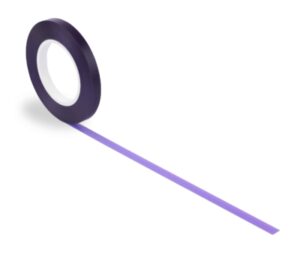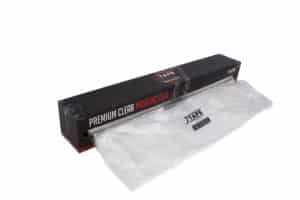How to Mask & Paint a Two Tone Car
Car owners often want their vehicles to stand out from the crowd. Whether they’re looking to breathe some life into an old car or want a unique finish on a modern vehicle, a two tone paint style can be an ideal solution for many. Offering two tone automotive painting might not be as popular nowadays, but it’s still a great way for car owners to achieve a unique design with just two paint colours. Plus, it seems to be creeping its way back into fashion, with many manufacturers like Mini and Land Rover offering it in their regular trim packages.
As professionals, you might see more and more customers coming to you asking for a two tone paint job, but perfecting this technique will require some practice. It’s not as simple as just getting the two colours onto the car’s exterior – you’ll need to consider all the layers of paint involved in the job, from the base to the gloss.
So what’s the best way to achieve this finish? In this guide, we’ll provide you with the products you need, some two-tone inspiration and step-by-step instructions to ensure you nail your application.
Best Tapes for Two Tone Painting
Having the right tapes and films to hand is a must for getting the finish right on your two tone paint job. Below, we’ll go through our top products that will make the job as simple and easy as possible.
Fine Line Masking Tape

Our Fine Line Masking Tapes are perfect for creating strong, defined lines around the surface of the exterior. Whether you’re painting around bends on the roof or sectioning off the side panels of the vehicle, our range offers the best solution for spray painting. No matter what colours you’re using, the tape is excellent at preventing leaking or bleeding.
Our masking tapes come in multiple colours, including purple, blue, green and orange. Click the links for each one to discover their unique properties.
Premium Clear Masking Film

Because it’s important to section off the two paint tones, a good masking film is essential. Our Premium Clear Masking Film is tough, tear-resistant and heat-resistant up to 150°C, alongside being Corona treated. This film does an excellent job of holding paint overspray and preventing paint contamination, keeping your job as neat as possible.
Two Tone Car Paint Ideas
Looking for some inspiration for different two tone designs? When you’re offering this finish as a service, it can be important to have a few ideas in mind to help your clients come to a decision that suits their wants and needs.
Below, we’ll give you some popular two tone paint ideas for cars.
Hard lines
Probably the most classic option, a hard lines approach gives you a clear separation between the two colours used. These lines can be created anywhere, but some popular placements include using a different colour for the roof than the body, changing the colour of the wing mirrors and creating thick lines across the bonnet and roof.
Colour fade
Usually done with similar tones or shades, but can be achieved with contrasting colours, a colour fade often starts with one colour at the top taking up two-thirds of the vehicle, then switches to another at the bottom. A colour fade can be much less obvious and works well if the client wants a more understated look while still using two paint colours.
Pearl effect
Slightly different from the other two, this finish is achieved by applying a special pearl paint to the existing base coat on the vehicle. As a result, a different colour will be visible when looking at the surface under different lights. This option can create a really unique effect when used on an unusual base colour such as purple or green. Therefore, this might be best to recommend when somebody comes in looking for an out-of-the-ordinary finish.
How to Mask & Paint a Car for Two Tone Paint
Now that you know the different finishes that can be achieved and the best products to use, you should be ready to learn how to mask and paint a car for two tone paint. In this section, we’ll take you through every you need to know, step by step.
Step 1: Mask off the different areas of the car
If different parts of the car are going to be different colours, you’ll need to mask these off using Fine Line Masking Tape and Masking Film. For example, if the roof is going to be blue while only the top of the door panels will be blue and the bottom will be white, then you’ll want to completely cover the roof.
To do this, apply Fine Line Masking Tape around the edges of the roof where it meets the windscreen and the top of the doors. The placement may vary depending on what the customer wants and the type of vehicle you’re preparing to paint. You’ll then want to lay your film over the roof and cut it down to size. Once you’re happy, add another layer of Premium Masking Tape around the film to secure it.
Step 2: Apply the sealer coat
Once any block colour sections are masked off, apply a sealer coat to the area where the transition lines will meet. This will create a good base for both colours and means you have more leeway in the following applications.
Step 3: Apply two layers of base coat & a clear coat
Starting with the lightest shade, spray two layers of your base coat over the entire panel where the two colours will meet. You can then apply two layers of clear coat to seal this in.
Step 4: Wet sand the panel
Wet sanding the entire panel will give the perfect base for applying your second darker colour.
Click here to learn how to wet sand a car.
Step 5: Apply Fine Line Masking Tape for the transition line
Working in one continuous line as our tape was designed to do well, lay your Fine Line Masking Tape down where you want the two colours to meet. This will usually depend on the car you’re working on and the requirements of the customer.
The main thing to check is that the tape is stuck firmly to the bodywork since this will create a solid barrier and prevent the paint from bleeding.
Step 6: Apply your final paint layers
Before starting this paint application, you might need to mask off the car windows. See our guide for help with this.
Two applications of your darker colour should do the trick, and this should be sprayed up to the line. Again, you’ll need to apply Masking Film over the lighter area to prevent overspray.
While this layer is still tacky, carefully remove the tape and film. You should be left with a clean, solid line when using our tape products.
You can then apply a clear coat to protect the paint job and ensure everything is smooth, and once this is dry, you’re finished.
Our top tips:
- Paint the lightest tone first – This will help you achieve clean lines.
- Take your time getting the line placement right – It’s best to be happy before you start painting and you should also have a clear idea of what the customer wants.
- Think about the layers and how they’ll work during the painting process – The sealer and extra clear coat provide leeway if you need to sand anything down.
Using this guide and our excellent range of tape products, we hope you can perfect your techniques and offer your clients the best two tone paint jobs that meet their requirements.


